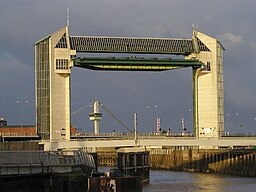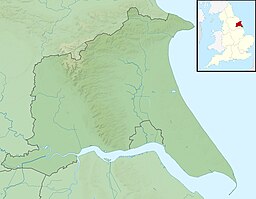Ennerdale Link Bridges
| River Hull | |
|
The tidal barrier at the mouth of the river
|
|
| Country | England |
|---|---|
| County | East Riding of Yorkshire |
| Source | |
| - location | Driffield |
| - elevation | 65 ft (20 m) |
| Mouth | Humber estuary |
| - location | Kingston upon Hull |
| - elevation | 0 ft (0 m) |
| - coordinates | 53°44′20.17″N 0°19′52.3″W / 53.7389361°N 0.331194°W |
| Discharge | for Hempholme Lock |
| - average | 3.4 m3/s (120 cu ft/s) |
|
Mouth of the river shown within the East Riding of Yorkshire
|
|
The River Hull is a navigable river in the East Riding of Yorkshire in Northern England. It rises from a series of springs to the west of Driffield, and enters the Humber estuary at Kingston upon Hull. Following a period when the Archbishops of York charged tolls for its use, it became a free navigation. The upper reaches became part of the Driffield Navigation from 1770, after which they were again subject to tolls, and the section within the city of Hull came under the jurisdiction of the Port of Hull, with the same result.
Most of its course is through low-lying land that is at or just above sea level, and regular flooding has been a long-standing problem along the waterway. Drainage schemes to alleviate it were constructed on both sides of the river. The Holderness Drainage scheme to the east was completed in 1772, with a second phase in 1805, and the Beverley and Barmston Drain to the west was completed in 1810. Since 1980, the mouth of the river has been protected by a tidal barrier at the estuary, which can be closed to prevent tidal surges entering the river system and causing flooding upriver.
Most of the bridges which cross the river are movable, to allow shipping to pass. There are six swing bridges; four bascule bridges, two of which have twin leaves, one for each carriageway of the roads which they carry; and three Scherzer lift bridges, which are a type of rolling bascule bridge. Scott Street Bridge, which is now permanently raised, was originally powered from a high pressure water main maintained by the first public power distribution company in the world.
The source of the River Hull is in the Yorkshire Wolds. It rises from a series of springs to the west of Driffield, near the site of the medieval village of Elmswell. The Elmswell Beck flows eastwards from these, and is joined by the Little Driffield Beck, which flows southwards from Little Driffield. It continues as the Driffield Beck, flowing around the south-western edge of Driffield, where it is joined by the Driffield Trout Stream. After the junction, it becomes the River Hull or the West Beck and flows to the east, before turning south to reach Corps Landing. For much of the route below Driffield, the Driffield Navigation runs parallel to the river.
...
Wikipedia


